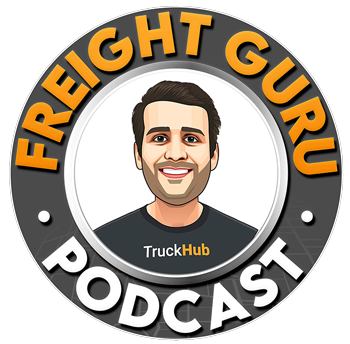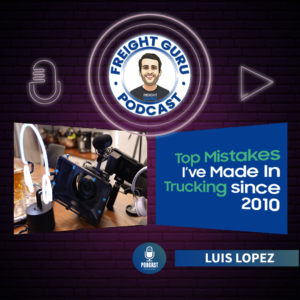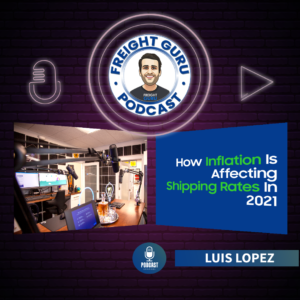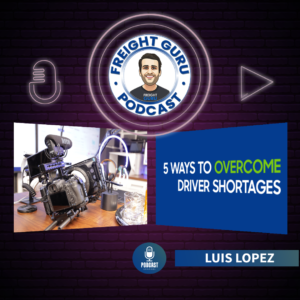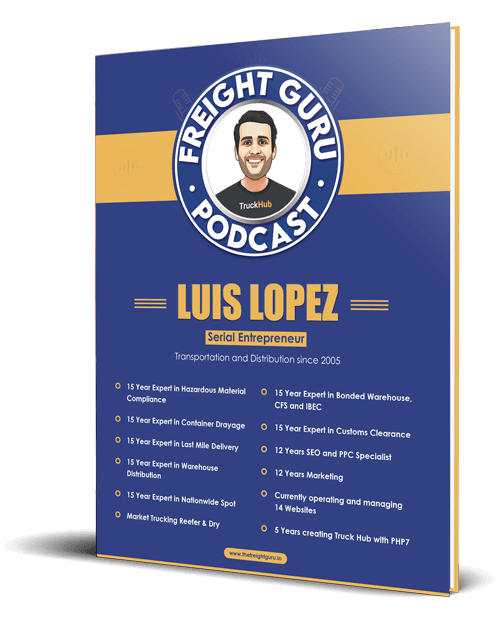Intro
On today’s podcast, we have a special guest. John Crassel is an insurance broker from right here in South Florida. He works for assured partners, who are a leader in the transport insurance industry.
We will be asking John some of the major questions that most carriers will have about their insurance and go over some principles of day-to-day operations. Specifically, we want to ask: “How much coverage do I need?”, “can I adjust a policy to account for scaling or downsizing?”, and “What factors are affecting my insurance premium?”. It is important to remember that just because you have a good premium this year does not mean you will get that rate when your policy expires.
About John
John started in the industry as a drayage operator about 20 years ago. He worked with several intermodal trucking companies that were moving things in and out of ports. During this time, John mostly managed compliance and insurance claims. He had 17-18 years of experience before moving to the insurance industry. He now works on insuring clients similar to what he had been doing and companies that operate in other areas.
This industry experience makes John somewhat unique in the insurance world. That means he understands the jargon & inefficiencies of the industry and aspects like driver onboarding in the ongoing driver shortage. He also understands how customers pay, hazmat, bondage, validation, etc.
Target audience
This podcast’s target audience is young entrepreneurs and people in this industry who would like to start their own operation. We are seeking to provide viewers with how-tos and industry knowledge based on our experience.
How much coverage you need
The amount of coverage you need depends on the type of operations you are managing. There are three basic types of trucking: Last-mile delivery, which uses box trucks, vans, 53’ trailers, etc. and is generally less than 50mi; Container drayage, which involves rail and port pickups and delivery from there; and OTR, which covers all 48 contiguous states and where you expect drivers to move 3,000mi/week. With OTR, you have unlimited locations. There are two types of OTR. There is the spot market, which is transactional. On top of that, you have contracted work where you see dedicated lanes, and you work on a quarterly, monthly, or yearly basis.
Your minimum coverage will depend on what type of carrier you are and what you carry. If you are doing interstate, intrastate, carrying passengers, hazmat, etc., each will require different insurance amounts.
When dealing with long-haul OTR trucking, you need operating authority with the FMCSA (Federal Motor Carrier Safety Administration). They mandate that you have at least $750k of liability insurance. However, many large freight brokers will require a $1M liability minimum, or, depending on the agreement, it may range higher still. When dealing with drayage insurance, the UIIA sets the limits. The UIIA (Uniform Intermodal Interchange and Facilities Access Agreement) is the industry-leading organization for setting compliance standards and interchange agreements with steamship lines.
When getting insurance for your drayage service, you need to make sure that your provider is UIIA certified. Some insurance companies have filed with both the UIIA and the FMCSA. A filing is something posted with the FMCSA confirming your financial responsibility.
In summary, if you are going to be an initial carrier or you are moving from last mile to OTR, you will need $750k-$1M in insurance. Hazmat transport requires $1M in auto-only coverage, as do most big brokers. You will also need to acquire physical damage insurance and cargo insurance.
Onboarding as an Insurance Provider
When onboarding and vetting companies, we generally offer a separate cargo coverage policy underwritten by a different company. People generally prefer the two to be separate in the case of a catastrophic loss. Typical cargo coverage is around $100k but frequently can be $250k or higher. We can also arrange specific increases in coverage if you need it for a single customer or order but do not wish to raise your coverage more broadly.
You must try to specify the loads you carry to the best of your ability. Often carriers will only put FAK and general goods when they might be handling personal effects and high-value commodities. Transparency is incredibly essential, and even if you do not know exactly the types of cargo you are moving, you should be able to mention at least 80% of your loads. Underwriters do not like surprises, and if there is a material misrepresentation, they can refuse to cover an incident.
Can I get Combined Deductibles?
It depends on what you wish to combine. Often, physical damage has separate deductibles for the power unit and the trailer, but for a fee, those can be combined. However, you cannot combine cargo insurance and auto liability.
What is the Best Deductible?
The deductible is a decision that must be made on a case-by-case basis by the business owner. When we are offering packages, we will present options with both $5,000 and $1,000 deductibles. It is ultimately a risk tolerance thing. A larger company will generally be better able to eat $5,000, and so the savings on the premium may be worth it in the long run, but again it depends on just how much skin you want to have in the game.
How Quickly Can You Change A Policy?
Outbound tender rejections are up massively, and class 8 vehicle sales up 44%. That means we are seeing unprecedented demand for transportation. As a result, many companies are tripping over themselves to expand to fill this demand. With this, it is essential to let your brokers and underwriters know the situation you are in. If say you are operating 3-5 trucks and you want to move to 15 trucks, you need to let them know and see what they are willing to do. When possible, it is best to let them know about expansion plans when hammering out your policy. You should also keep them posted on your corporate operations throughout the life of your policy.
Insurance-Customer Relations
In the insurance business, your relationship with your customer is an ongoing active affair from the moment the ink has dried until the expiration of the policy. Constant communication is what sets transport agents apart from general-purpose agents. There is lots of customer service. This includes things like units coming on and off, answering questions, and many other aspects that make it more of a partnership. The role of the broker is to be a client advocate and handle reporting claims, doing renewals, and those sorts of things.
Why Do Insurance Premiums Keep Going Up
The big question everyone asks is why insurance premiums are shooting up year over year. Some broader industry factors are contributing to this. Among these are some of the nuclear insurance verdicts you have seen in recent years. There is also a lot of consolidation in the industry that you have seen. That means that today there are not many options when looking for cargo insurance. These factors and others mean that carriers who are doing all the right things and limiting theft, claims, and damage for 5+ years and still seeing increases of 11-12% in their premiums.
This situation is difficult because of how cost-competitive the industry is. When you see someone charging $50 less for a container moving out of the Port of Miami, you wonder how that is possible. It also becomes challenging to maintain customer relations because even if you are trying to give them the best rate possible, you still have to raise the price on them over time.
It can also feel like an effort in futility because you will invest massively in compliance and be above and beyond in drug testing, all while only hiring drivers with three years of experience or more, and you still get hit with an 11% rate hike.
What Underwriters Look at Most
There are a few things that underwriters put a lot of weight on. Among these are loss history, claim frequency, and severity. Of those three, the one that has the most weight is claim frequency. Generally, underwriters would prefer a shock loss, aka policy limit claim, to a high claim frequency.
The Issue With Trucking Accidents
One of the greatest difficulties with trucking accidents is the natural human response is to assume that the trucker is at fault. Take, for example, a large tractor-trailer that collides with a small car, like a Toyota Corolla® in most cases, the trailer will be largely untouched, and the Corolla® will be in pieces. When people look at that, they tend to assume the trucker is at fault. In actuality, 75% of collisions between trucks and passenger vehicles, in situations where the trucker has a dashcam, are the passenger vehicle’s fault.
The Importance of Trucking and the Driver Shortage
While many look down on trucking, it is the lifeblood of America and the world as a whole. Without trucking, you do not get food in grocery stores or clothes at target. Truck drivers go through immense sacrifice. They sleep in small cabins and have to utilize public showers amid a pandemic. With this difficulty, you see the older generation of truckers starting to get to retirement age while very few younger people are getting into trucking.
Attempts to get younger people into trucking including, the rise of automatic transmissions in trucks. However, these efforts have not borne much fruit as of yet. Many of the younger drivers who are joining the industry are strongly against being away for long periods. That is drawing them more to regional carriers, with whom they can be home on weekends and spend more time with families. That leaves national carriers finding an even harder time recruiting younger drivers.
Rising Costs in Trucking
Truck parking is difficult, and the system around it is largely obsolete. Outside of truck stops, you are paying $5-7k/acre for your land, and most of the time, you do not get paid yard/storage fees, all while the cost of land continues to rise. On top of this, you see rising driver costs, fuel rates, and insurance rates. Truck parking is also incredibly scarce in major metropolitan areas. On the whole, prices are going up, and it is making it difficult for the industry.
The Permanence of Trucking
Trucking is not going anywhere anytime soon. Products still need to be moved, and even when you use air, rail, or sea to cover the bulk of the journey, you still need trucks to get these packages and containers from the transport depot to the warehouses and customers who need them. Even amazon uses trucks to interface between air and warehouse.
Compliance and Violations
One thing that can affect your premiums is roadside inspection history. If your insurance providers see that you have repeated violations for vehicle maintenance, driver fitness, or hours of service, it will raise flags. Such incidents boost the likelihood of you having to file a claim.
It is essential to make sure that you check the results of your inspections frequently so that you can file a dispute if you believe a violation was handed out in error so that you can have it expunged from your safety record.
The FMCSA has a website called DataQs. You should register so you can see any issues and correct them if necessary. You should also be using the SAFER system, which, if you are registered, can show reports within 48 hours. This way, you can find out potentially even before your driver gets back.
Penalties for Violations
It is essential to file reports when drivers fail to comply with regulations and make sure they are warned/penalized for it. If they are continually failing to meet ELD mandates, they need to be, warned, penalized, and, if it continues, terminated. The DOT is aware that there are families and pedestrians on America’s roads, and they will not allow you to create hazards. Moreover, if insurers catch wind of repeated violations your rates will go up.
Thank you for reading, and make sure to check out the full podcast available here!
The Freight Guru
ll@thefreightguru.io
